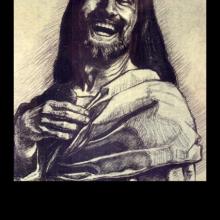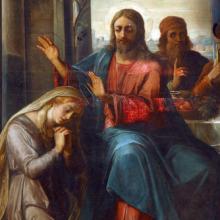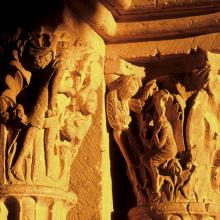mary magdalene
Mary Magdalene was suffering / in her body, mind and soul — / until Jesus met her, offering / love that made the wounded whole.
IN THE OPENING scene of Cecil B. DeMille’s 1927 silent film The King of Kings, a scantily clad but opulently accessorized Mary Magdalene reclines on a lush chaise lounge, caressing a cheetah. She’s an upper-class prostitute, and she learns that Judas, one of her clients, has left her to follow a carpenter. Furious, Mary demands, “Harness my zebras—gift of the Nubian King! This Carpenter shall learn that he cannot hold a man from Mary Magdalene!”
Before she mounts her chariot, someone wagers a purse of gold that she won’t be able to take Judas back from Jesus, because Jesus has magical power to heal the blind. Mary scoffs in reply, “I take thy wager—I have blinded more men than He hath ever healed!”
An angry, haughty Mary finds Jesus, but when he looks at her, she is shaken and steps back. Jesus begins to heal her of seven demons, which emerge one by one from her body like ghosts. After the demons have departed, Mary looks down at her partially naked body, picks up her cloak to cover her skin and hair, then kneels at Jesus’ feet. He pats her head, as if patting a child, and looks away, speaking not to her, but to a man beside him.
I had enjoyed Mary Magdalene’s exotic transportation via zebras, her fury at being scorned, her verbal sparring with the men who doubt her ability to win Judas back. But as I watched the “demons” drain out of her, I felt her life draining too. Now docile and meek, she responds to healing by clothing herself more modestly. The viewer, I take it, is supposed to feel amazed at her transformation. Instead, I felt horror, like I was watching Christianity’s centuries-long suppression of women captured in a 20-second clip, with Mary Magdalene standing in for all of us. The film was silent, but I could hear it speaking to women loud and clear: “Cover up. Lower your eyes. Kneel. Repent. Leave your body and your sexuality behind. Submit. That’s a good girl. You are allowed to belong now.”
Centuries of obsession
WHILE CHEETAHS AND zebras and Judas as Mary’s patron were new adornments to the Mary Magdalene story, the rest of the film’s portrayal was consistent with how Mary has been painted in popular culture for the last 1,500 years: Mary, the prostitute and sinner, turned repentant.
In the earliest accounts, Mary Magdalene is never called a prostitute. Luke 8 says she was healed of demons, but nothing is mentioned about her line of work. It is not until 591 C.E. that Pope Gregory I preaches a sermon calling Mary Magdalene a prostitute, and the misidentification has stuck.
THE NEW TESTAMENT stories of Mary Magdalene—and the way the church has treated her since biblical times—tell us a lot about the church today, and perhaps even more about our still-patriarchal society in general. In scripture, and in other contemporaneous documents, Mary is portrayed as one of Jesus’ closest confidants; after his resurrection, Jesus appears to her first and commissions her to tell the others (John 20). But, as Kyndall Rae Rothaus explains in this issue, the church has had a difficult time accepting the biblical portrait of Mary as one of Jesus’ closest and most faithful disciples. Instead, beginning most notably with a 6th- century papal sermon that called her a prostitute, Mary has been portrayed as a “fallen woman” in need of repentance or, sometimes, as Jesus’ lover, but not as the “apostle to the apostles” she became by merit.
Why we need to free the "apostle to the apostles" from centuries of myth and distortion.
TWO WEEKS AFTER Kanye West released a gospel album with watered-down theology in October 2019, British singer-songwriter FKA Twigs dropped a marvelous piece of sparse electronica with a spiritual tenor. Twigs’ album is gospel in its theological significance. West’s record is not.
Titled Magdalene, the 32-year-old Twigs’ second album is a “revelation,” according to Pitchfork. Throughout the album, the dancer-turned-R&B-genre-bender finds strength in the story of Mary Magdalene. The record’s title track focuses on the Magdalene and the social implications of Jesus’ relationship with her.
Twigs frames the album as a feminist reconsideration of Mary’s story, pushing back on the fact that her narrative was ultimately told by male writers. Outside of Jesus’ family, she is the woman most mentioned in the gospels. She was a patron of Jesus’ ministry and among the first to have seen him resurrected. However, throughout much of history she has been conflated with the “sinful woman” in Luke 7 and, as a result, seen as sexually promiscuous. Twigs pushes against this patriarchal gaze and turns to the Magdalene for inspiration.
I can tell from the way
they are staring at shadows on the ground
that the voice-bearers have come
from that place where
trees are not life-giving.
Two nights ago, One was here with them
Whose longing, love, and pain woke my soul,
deep-buried,
which sleeps through winter,
moth-like.
He is not here with them now.
In the newest cinematic Mary Magdalene, directed by Garth Davis from a script by Helen Edmundson and Philippa Goslett, Mary isn’t confused at all. I don’t think anyone was expecting a film with that title to appear unironically in 2019; it's also a genuine surprise that it wasn’t made for the Christian market, nor does it aim for the kind of dry, “noble” distance that makes large-scale biblical epics such as Ben-Hur seem like Downton Abbey, upstairs, with sandals. The fact that Mary Magdalene contains decent performances (especially Rooney Mara’s Mary, not a doe-eyed holy innocent, but a leader who finds her voice by speaking), and makes an honest effort at exploring the less familiar parts of one of the most familiar stories in history makes it worth our attention. That attention may even be rewarded by an idea or two. It’s thoughtful, honest, yet not earth-shattering cinema, although it does bring its own revelation.
In the midst of so much death, how can we Christians celebrate Easter?
These questions can be paired with questions regarding our own sense of worship on that day. How much have we Christians replaced justice with worship, not taking one into serious relation with the other? Are we accustomed to worship in the total absence of justice?
A recent Washington Post profile of Karen Pence mentioned that her husband, Vice President Mike Pence, never eats alone with another woman or goes without her to events where alcohol is being served.
Twitter erupted with outrage and ridicule.
But the Indiana Republican’s practice is not unusual in many conservative Christian circles. As Emma Green pointed out in The Atlantic, it likely stems from something called “the Billy Graham Rule,” named for the 98-year-old international evangelist. Nor is it that much different in intention from the practices of conservative Jews and Muslims.

"Magdalen," by Georges de la Tour. Image via Everett - Art/Shutterstock.com
The woman who preached the first Easter sermon is known more for a fictionalized relationship with the Christ than for the words of light and life she brought to the world. The woman who stood by the cross until Jesus took his last breath is characterized by sexual promiscuity — one that is nowhere within the recounting of her ministry and her faithfulness.
This is Holy Week, the most sacred time of year for Christians. It is the time they mark the betrayal, trial, and crucifixion of Jesus, and a week that culminates in Easter Sunday, the day Christians believe Jesus rose from the dead. So what do colored eggs have to do with anything? Let us Egg-‘Splain …
Q: Is Holy Week really a whole week? I only know about Good Friday and Easter Sunday.
A: Holy Week is the entire week between Palm Sunday and Easter Sunday. Not a whole lot happens on Monday and Tuesday, but some Christians mark the crucifixion on Wednesday, and some celebrate Maundy Thursday, the day of the Last Supper, Jesus’ final Passover meal with his disciples. It is sometimes celebrated with a foot-washing ceremony, a tradition beloved by Pope Francis, and a “Pascha” or “Paschal” meal, derived from the Jewish Passover Jesus would have known. Then comes Good Friday, Holy Saturday, and Easter Sunday. Fun fact: Not all American Christians greet each other with “Happy Easter.” To many evangelicals, the day is “Resurrection Sunday,” in part because they believe the word “Easter” has pagan roots.
Q: What is so “good” about Good Friday, the day Jesus was horribly tortured to death?
Another day, another stunning blockbuster report that … Jesus was married! And to Mary Magdalene!
The latest version of this meme comes from Simcha Jacobovici, an author and filmmaker who is famous for promoting stunning theories about Jesus that on further review often turn out to be dubious.
Jacobovici’s new claim that he has decoded an old text that reveals Jesus and the Magdalene were married and had two kids (and she was a “co-deity” with her husband) came out this month and has also been widely dismissed.
But as happened earlier this year with the so-called “Gospel of Jesus’s Wife” — a suspect papyrus that receives a further debunking in the latest edition of the Atlantic — people find Jesus’ sex life endlessly fascinating, and plausible.
Why is that? Here are five reasons.
Water tower located in Pleasantville, Iowa. By Ashton B Crew for Photo taken for www.randomiowa.com. Via Wikimedia Commons
In some way or other, I think it’s safe to say that we all have a kind of nostalgia for the innocence and purity of the Garden of Eden before what we call “the fall.” We have a sense that we are not supposed to be outside the gates of the Garden … out here. At the expulsion of the man and the woman in the story from Genesis, the cherubim (angels) are posted at the gate to be sure that those who have been expelled cannot get back in. The cherubim and a twirling, flaming sword keep Adam, Eve — you, me, all of us — on this side of the gate, outside the Garden of Eden.
Well it’s a story, of course, but isn’t it our story? Nostalgic for a world where nothing ever goes wrong. But illness comes, a marriage goes bad, a relationship with someone you love falls apart just when you think it’s to lead to something more permanent, you lose a job, you suffer depression, you suffer from an illness, you’re left alone in grief over the loss of a loved one. Or you yourself are dying, and there are wars and rumors of wars. We watch the children and wish that we could protect them, but we can’t, even though we are parents and grandchildren, aunts and uncles. Out here, outside the Garden, it’s rough sometimes.
For the sake of the world, we should all be feminists. And given what we know about the role of independent, empowered women in the community of disciples, for the sake world, we might be “Christians.”
Raymond Brown, the late, great scholar of John, writes: “In this Gospel, where light and darkness play such a role, darkness lasts until someone believes in the risen Jesus.”
Therefore no darkness, no heartbreak, no grief, no injustice can long stand where the Risen Christ is proclaimed. Jesus Christ is the light of the world. The light shines in the darknessa and the darkness does not — cannot — will not overcome the light.
Last Friday was International Women’s Day. It was a day of celebrating how far we’ve come, but also a reminder of how far we need to go.
I’m reminded of an experience I had with a member of my youth group a few years ago. We were volunteering for a social service project. A member of the group happened to be named Eve and we thought it was fun to play up the joke. I’d start greeting people, “Hi! I’m Adam,” and then Eve would chime in, “and I’m Eve!”
We always received the strangest looks, which, of course, is why we did it. But this time it was different. A man at the service project actually said,
“Oh. So you’re the one to blame.”
Eve was able to laugh it off and respond with grace, but I was pissed. I instinctively scowled at the man. It was a deep blow to me because, once again, religion was being used to put women down. But this time it was personal. Religion was being used to put down a member of my youth group.
Of course, religion hasn’t always been good to women. Or, maybe it would be better to say that religious men have used religion as a weapon to make women feel inferior. Whenever we blame someone else it’s a sign of our own weakness and insecurities. We don’t have the courage to deal with our own inner turmoil so we blame someone else. This is classic scapegoating and we men have been scapegoating women in this way since the beginning of human history. It’s pathetic. International Women’s Day is a reminder to me that women and men need to work together to end the religious bigotry against women.
My model for this is Jesus, my favorite feminist. [1]
So, in the spirit of International Women’s Day, I offer you the top 4 ways Jesus included women as full members of his posse.
EVER SINCE THE apostles positioned Mary Magdalene as an “unreliable narrator” telling an “idle tale” in Jesus’ resurrection story, some men in the church have claimed maleness as normative and orthodox and femaleness as, well, not.
In the recent case of the Vatican vs. the Leadership Conference of Women Religious (LCWR), the integrity of women’s witness is, once again, called into question by male hierarchs.
These Catholic sisters represent an unbroken, cohesive expression of faith in the history of American Catholicism and in women’s presumption of equality, completeness, and active moral agency both under law and under God—a presumption that is a shining light for women around the world. The sisters might have once shared accolades for faithful servant leadership with their brother priests, bishops, and cardinals, but over the course of nearly 30 years of unfolding pedophilia scandal and blasphemous mob-like cover-up, the laity has learned to look to the sisters alone for examples of Catholic gospel witness and Christian maturity, strength, and just plain grit.
But let’s not sideline this issue as “a Catholic thing.” We don’t get off that easy. The struggle over women’s authority runs right through the denominational diaspora of the body of Christ.
The Gospel of St. Matthew, Chapter 28 tells us:
The angel spoke to the women: "There is nothing to fear here. I know you're looking for Jesus, the One they nailed to the cross. He is not here. He was raised, just as he said. Come and look at the place where he was placed.
"Now, get on your way quickly and tell his disciples, 'He is risen from the dead. He is going on ahead of you to Galilee. You will see him there.' That's the message."
To listen to a playlist of music for this Resurrection Day 2012, CLICK HERE.
Albert Camus once said that your life is “the slow trek to recover the two or three simple images in whose presence [your] heart first moved.”
Sebastian Moore recovered one of those images after he had wandered into church at vespers on the Feast of the Sacred Heart.
In his book, The Inner Loneliness, Moore describes that moment of awakening. It came one evening after lots of pasta, a lot of spaghetti, and a lot of wine. “As I entered the church, I heard the familiar words [in Latin] ‘One of the soldiers opened his side with a spear, and immediately there came forth blood and water.’ And I had what can only describe as a sense of fullness of truth. Somehow, everything that was to be said about life and its renewing was in those words. Somehow my life, my destiny, was in those words.”
The image that moved his heart became one to which he returns daily, as do I. For the piercing of the side of the helpless man hanging on the cross happened not just then and there at Golgotha; it happens here and there and everywhere when we torture our own souls or the souls of others because we, or they, have failed to measure up to what we expected. Strangely, it is in the piercing that brings blood that we are cleansed by the living water that pours from his side.
Do you see your life in the words and in the image of the spearing of his side, in the blood, but also the water that heals, restores and renews, flowing from his pierced side?
A second image came to me this week on a photography blog of religious architecture by Dennis Aubrey.
Our current practice in the U.S. actually reflects the earlier legal reality of coverture: In the process of the "two becoming one flesh," the wife lost her rights to property, legal representation in court, and even her public identity as her husband became the sole representative for the family. This combination of identities (or, rather, the wife becoming lost in her husband's identity) led to wives taking their husbands' last names. For me, losing my surname would have represented silent assent to this oppressive practice.















